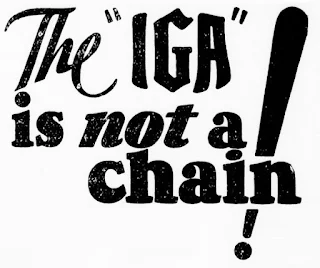Our fifteenth -and final- Food Store Focus covers the Independent Grocers Alliance, or IGA, which was formed in May 1926. Joseph Frank Grimes, a partner in a Chicago accounting firm, understood the logistics of grocery wholesaling. He felt that the nation's independent grocers needed a fresh and innovative business model in order to compete with huge chain store operations, such as A & P and Kroger.
Graphic from the Independent Grocers Alliance, Incorporated
Grimes and five associates travelled from the Windy City to Poughkeepsie, New York, where they were to meet with officials of a food wholesaling company and various independent grocers. On the way, Gene Flack -one of Grimes' team- created the trademark seen above. The meeting, where Grimes explained his new grocery store concept, was a success. Sixty-nine grocers joined a newly-formed Independent Grocers Alliance. By late 1926, there were 150 affiliated IGA stores.
Graphic from the Independent Grocers Alliance, Incorporated
Grimes was adamant that an IGA was not a chain store. Under his plan, all stores were owner-operated and would be supervised by a Chicago corporate headquarters. The enterprise would be an alliance between stores, wholesalers and vendors. Moreover, IGA would provide marketing and access to a constant chain of supply. Within a few years, IGA began manufacturing its own house brand canned goods. In 1930, there were over 8,000 IGA stores in thirty-six states, with most units serving small towns.
Advert from the Independent Grocers Alliance, Incorporated
A.E. Trundy and associates stand in front of an eastern Maine IGA. The date, 1940. IGA stores usually included the owner's surname on its nameplate. In 1940, the typical store covered 1,000 square feet. Several units followed the IGA model store layout, which dictated that produce should be displayed on the right. A meat counter should be along the back wall of said store, with dairy cases along the store's left side.
Photo from the Southwest Harbor Public Library / Maine
In January 1940, a large IGA opened in Goose Creek, Texas. It encompassed 4,500 square feet. An even larger store format store was introduced in Wisconsin Rapids, Wisconsin in July 1945. Known as IGA Foodliner, it was required to encompass over 4,000 square feet and do a monthly business in excess of $7,500. The Wisconsin Rapids unit covered 15,100 square feet.
Graphic from the Independent Grocers Alliance, Incorporated
IGA was an original tenant at America's first shopping mall. The Foodliner at Seattle's NORTHGATE CENTER welcomed first customers in July 1950. The store encompassed 20,000 square feet. By 1957, there were 400 Foodliners in operation.
Photo from http://archives.seattle.gov / Seattle Municipal Archives
In 1953, IGA was supplying 5,300 stores. By 1960, there were 6,000 in forty-eight states and Canada. Self-service meat counters had replaced all older full-service facilities. By 1970, IGA was servicing 3,700 stores. In 1973, the corporate headquarters moved from the downtown Chicago "Loop" to a new facility in the vicinity of O'Hare International Airport.
Graphic from the Independent Grocers Alliance, Incorporated
The first Canadian franchise had been established in 1950. An Australian division formed in 1988. The first stores in China opened in 1994. IGA also has franchises in locales such as Brazil, South Africa, Namibia, Japan and Indonesia. The structure of food retail in Western Europe and the UK has prevented any independent grocery companies from gaining a foothold.
Graphic from the Independent Grocers Alliance, Incorporated
Over the years, several store formats evolved. In addition to the IGA Foodliner, there were IGA Food Town, IGA Food Farm and IGA Discounter. In more recent times, formats such as IGA Marketplace were developed, which are large units with as much as 56,200 square feet. At the same time, a contemporary Hometown IGA could cover as little as 5,600. The store shown above opened -in Springboro, Ohio- in 1958 and was shuttered in 2014.
Photo from Wikipedia / Ed!"
Graphic from the Independent Grocers Alliance, Incorporated
IGA JUNIOR-ANCHORED SHOPPING MALLS:
*NORTHGATE CENTER, Seattle, WA (1950) [IGA Foodliner]
*MAINE MALL, South Portland, ME (1971) [IGA Gold Star Market]
*GRAND CENTRAL MALL, Vienna, WV (1976) [Darrels IGA] [outparcel]















